Abstract
This study attempts to verify whether green-marketing efforts of companies are recognised by the Polish customer in social media—a vital marketing communication channel. For businesses, this awareness carries important implications for the effectiveness and profitability of the eco-marketing campaigns. This study employed survey methodology, which was coupled with participant observation of online ecology-centred communities. It is shown that the economic aspect of green marketing is valued by customers and they are quite observant with respect to such expressions of eco-marketing as eco-organic product packaging or production in the spirit of zero-waste technology. The results indicate that eco-marketing activities should be predominantly targeted at women because they are more likely to take note of the message. The statistical part of the study utilises the Chi-square (χ2) test (significance level α = 0.05) and the gamma distribution. Eco-marketing activities appear to attract notice in social media, but not yet as much as presumably desired. Gender is shown to correlate with respect to questions regarding the noticeability of zero-waste activities and pro-ecological activities in social media. Women display higher awareness of “zero-waste” and pro-ecological social media campaigns. In the aggregate, those who perceive “zero waste” as a lifestyle include women, who are more observant.
1. Introduction
In the new global circumstances, eco-marketing is attracting widespread interest due to its connotations with sustainable development. Driven by the principles of corporate social responsibility (CSR), businesses have given this marketing trend the green light. The world of today is replete with social events and attitudes related to ecology and care for the natural environment. Purchasing decisions of modern customers are often impacted by eco-anxiety or even eco-depression. According to a 2018 Yale study, 70% of Americans are worried about climate change, 29% are very worried and 51% feel helpless [1]. A global 2019 study revealed that 7.6 million people fear detrimental climate changes [2]. The emergence of green marketing is the answer to these as well as other attitudes and expectations of customers. Although the concept has been circulating for quite some time, it can be safely stated that it is currently enjoying a revival in popularity among the big and small of the business world. It is a natural extension and development of corporate social responsibility, which not only responds to the needs of customers, but also awakens the interest in pro-ecological attitudes. According to “Who cares? Who does?”, a report on plastic waste avoidance carried out by the GfK market research institute, the Polish customer shows considerable interest in green solutions. A majority of respondents (77%) expressed their willingness to switch to packaging deposit schemes to refill their cosmetic and cleaning product containers at the shop. The GfK research indicates that manufacturers are widely expected to promote and implement pro-ecological behaviours on the market. A vast majority of customers (90%) demands decisive actions on the part of producers to curb plastic waste production. Three-fourths of respondents (75%) expressed the belief that customers should ignite the change, whereas 63% of interviewees emphasised the role of retailers in reducing the use of plastic [3].
Although eco-marketing has been studied in the past, e.g., by Papadas et al. [4], this research fills the gap by, firstly, presenting how Polish customers perceive eco-marketing in social media and, secondly, directly linking green marketing with social media communication. In addition, it addresses the area outside the scope of the previous research, whose focus was on customer purchases in response to traditional forms of communicating green marketing ideas, as in the article by Nedumaran et al. [5]. The purpose of this study is to acquire and process the data on social media eco-marketing in order to capture the current awareness of green marketing within Polish society. Given that nowadays, a range of social activities are drifting to the Internet, scientific observation and research ought to follow. According to a 2020 report prepared by WeAreSocial and Hootsuite, the most popular social networking sites in the world are Facebook, YouTube, WhatsApp, Facebook Messenger, the Chinese instant messenger WeChat and Instagram [6]. Many enterprises develop eco-marketing activities through social media, which is why it is important to verify whether and how these efforts are recognised and followed by customers.
2. Literature Review
The literature review for this study covers eco-marketing and social media. Eco-marketing is a concept bordering on corporate social responsibility and marketing activities, which is the subject of research in this article. On the other hand, social media is a specific environment in which the research was conducted. The research concerns the relationship between eco-marketing and social media in the area of marketing communication.
2.1. Eco-Marketing
The term eco-marketing was, however, coined by the American Marketing Association (AMA) at the 1975 Ecological Marketing seminar (Austin, Texas) [7]. The general concept is represented by several terms found in the literature, such as eco-marketing, ecological marketing [8], sustainable marketing [9,10], environmental marketing [11] or green marketing [12,13,14]. Considering the aspects investigated in this study, the definition that is closest to the spirit of the discussion is by K. Henion and C. T. Kinnear: “Ecological marketing involves all marketing activities: (1) those that appear as causes of environmental problems, and (2) those that assist in solving environmental problems. In this way, environmental marketing studies both positive and negative aspects of marketing activities in connection with pollution, exhaustion of energy sources and depletion of non-renewable resources” [8], as well as by V. Kumar, Z. Rahman, A.A. Kazmi and P. Goyal, which states that eco-marketing “builds long-lasting customer relationships effectively—without any particular reference to sustainable development or consideration of sustainability issues” [10].
The picture of green marketing that may be drawn from the definitions above has been the motivation for examining how we react to various activities in this field. It prompts questions regarding how green-marketing efforts of companies are recognised by the customer, particularly in social media—a vital marketing communication channel, which is the key point of reference for this study.
Among customers and researchers alike eco-marketing is primarily associated with appropriate product packaging [15]. The assumptions of pro-ecological activities of businesses indicate that the product packaging should be “compostable, biodegradable, refillable and/or reusable” as well as less concentrated and bought in bulk with less frequent purchase [16].
These declarations were tested using two research questions:
- Are Polish social media users familiar with the concept of eco-marketing?
- How popular is the topic of ecological packaging of products among Polish users of social media when they talk about the ecological activity of companies?
Other works indicate the impact of social media on customer decisions [17]—specifically, that when buying ecological products, customers are inclined to follow opinions obtained from social media and other users [18] (including influencers and institutional users). It emerges from the GfK report that the Polish customer is beginning to take note of zero waste activities of companies [3]. These observations were subjected to test by means of the following research question:
- 3.
- Are Polish social media users familiar with the concept of zero waste?
The scope and meaning of eco-marketing tend to be misinterpreted. It is viewed as limited to the promotion and provision of organic goods; obviously, however, it represents a vast concept encompassing customer goods, capital and services. It involves a variety of activities, focused on the entire life cycle of products and services to ensure the sustainable use of non-renewable resources and the preservation of biosystems critical to life. Mitigating the negative effect of consumption on the environment can be achieved by applying the strategies of eco-marketing mix and eco-labelling [13,19,20].
Eco-marketing mix combines the ideas of green product, green price, green promotion and green place to capitalise on products and services boasting such environmental incentives as reduced waste, improved energy efficiency or decreased release of toxic emissions [21,22,23,24]. Green price reflects the fact that manufacturing environmentally sound products is more cost-intensive. The objective function of such a process is minimising the energy and resource consumption at the expense of the price. Green products are friendlier to the environment and the underlying goal is for them not to become a source of short- or long-term hazards. A higher-than-usual price reflects the effort put into employing special machinery that does not harm the environment.
Previous studies show that customers are sensitive to purchases advertised as ecological [25].
Hence, a further research question is:
- 4.
- Is pricing a fundamental aspect of ecology-motivated purchases for Polish social media users?
2.2. Eco-Marketing and Social Media
Social media plays an important role in shaping customers’ attitudes and purchase intentions towards green products [26]. Given the above, we attempted to investigate the extent to which such variables as age, place of residence, gender or education affect the company’s eco-marketing activities in social media. The first step was to verify whether customers recognise the notions embedded in eco-marketing, which are presented in the following paragraph.
Circular “zero-waste” economy is one of the ideas that have emerged in response to the rising awareness of the global ecological crisis. In their nethnographic study, Zwier et al. [27] present the fundaments of the Bio-Based Economy (BBE), which shifts towards recognising the implications of abundance and wastefulness in search for a zero-waste humanity. The essence of zero waste is encapsulated by Asveld et al. [28], who explain that “the bio-economy should be an efficient economic system that produces no waste”. The study of the literature shows that the world of science has been taking active efforts to develop green solutions aimed to combat food waste and optimise the use of raw materials. As one of the outcomes, it is expected that in a short-term future, more compounds will be integrated into food coatings [29]. The influence of age, gender, occupation, marital status or occupation on the knowledge of waste liquidation through recycling, reuse and reducing the quantity of waste has been studied by authors [3,30,31], who have shown a strong correlation between these socio-demographic factors and the knowledge of the issue in question. To establish the state of knowledge of the zero-waste ideas among the respondents, the following research question was proposed:
- 5.
- Is the knowledge of “zero waste” dependent on Polish customers’ socio-demographic profile (age, place of residence, gender, education)?
“Zero waste” is directly associated with such notions as eco-marketing/ecological marketing/sustainable marketing/environmental marketing/green marketing, which were explained in detail in Section 2.1. The factors that motivate individuals to engage in pro-ecological activities have been under investigation for many decades [32,33,34]. It is observed that a socio-demographic stream implies a preoccupation with exploring who is more environmentalist—high-income/low-income individuals, man/woman, rich/poor countries. Patel et al. [35] show that specific green behaviours are related to age, gender and material status. Elsewhere [36], the social structural variables that were indicated as potentially relevant for the eco-friendly activity were age, gender, place of residence and education. Hence, our research question concerns the understanding of these terms among the respondents and was formulated as follows:
- 6.
- Is the familiarity with the concept of eco-marketing depends on Polish customers’ socio-demographic profile (age, place of residence, gender, education)?
Social media have been shown in the preceding paragraphs to play a vital role in shaping customer behaviour and demand for eco-friendly products [16,26], which is why the awareness of green marketing activities of businesses was investigated according with the two research questions:
- 7.
- Do Polish social media users notice pro-ecological activities of companies?
- 8.
- Do Polish social media users notice companies boasting about zero-waste activities in social media?
Nevertheless, the review of recent research has indicated that the socio-demographic aspect has not been investigated in the indicated scope in any of the former studies. In order to fill the existing gap in the knowledge on this subject, it seems important to study this topic in more detail. For this reason, it appeared relevant to investigate the relationship between the noticeability of companies boasting about zero-waste and pro-ecological activities in social media and the customers’ socio-demographic profile. On this basis, the research question is as follows:
- 9.
- Is noticeability of companies boasting about zero-waste or pro-ecological activities in social media dependent on Polish customers’ socio-demographic profile?
Another aspect that has not yet been investigated with respect to Polish customers is whether Polish social media users that are familiar with the concept of eco-marketing per se are aware of these activities in the social media. The issue was approached through research questions 10–13:
- 10.
- Are Polish social media users who are familiar with the concept of eco-marketing also familiar with the concept of zero waste?
- 11.
- Do Polish social media users who are familiar with the concept of eco-marketing also notice companies boasting about zero-waste/pro-ecological activities in social media?
- 12.
- Do Polish social media users who are familiar with the concept of zero waste also notice companies boasting about zero-waste/pro-ecological activities in social media?
- 13.
- Do Polish social media users who notice companies boasting about zero-waste activities in social media also notice their pro-ecological activities?
According to Otero Polo 2015 [37], women pay more attention to the quality of the product. This may indicate that they are also more susceptible to eco-marketing, which emphasises the high quality and health-promoting effect of products and production. A number of US studies have determined that women are more concerned with the environment than men [38]. Similar conclusions have been presented by Milfont et al. [39], supporting the view that these are women that exhibit more pro-ecological outlook than men. Gifford and Nilsson [36] point out that there are personal and social factors other than gender that influence environmental concern and pro-environmental behaviour, including waste avoidance attitudes [30]. Some studies have incorporated the role of gender into existing theoretical models of pro-environmental behaviour [31,40,41]. On the other hand, there are studies showing that gender differences are negligible in environmentalism [42]. On this basis, the research question is:
- 14.
- Do Polish women pay more attention to eco-activities in social media?
3. Materials and Methods
In our research, two techniques were employed: the participant observation methodology, adopted to study online communities centred around ecology, and a survey. The observation was performed by the authors of this study. We participated in the life of online zero-waste and green-marketing groups and communities on social media, such as Facebook. The 6-month study was conducted from October 2019 to March 2020, and the results from the ongoing observations dynamically altered the preparations for writing this report, including the review of literature.
The survey was carried out in February and March 2020 via the questionnaire sent to social media users. The choice of the medium was partly motivated by prior findings. The respondents were requested to reply to nine multiple-choice questions concerning eco-marketing and four demographics questions. The questionnaire was provided in an electronic form and disseminated on the Internet by the authors of this study. The sampling procedure was non-probabilistic and followed a snowball procedure. It was shared among users of Facebook public groups interested in zero waste and eco-marketing. In addition, the questionnaire was sent via email, Facebook Messenger and WhatsApp messaging applications to a larger group of recipients, who were asked to complete and forward it (a snowball method). The participation in the study was voluntary, and the anonymity of the study participants was ensured. The advantages of an online survey are that it is simple to deliver and collect. This is an important feature, given that the recipients are people who use the Internet every day.
The measuring instruments consisted of nine items with a different point scale, comprising statements related to a wide range of eco-marketing, zero waste and pro-ecological activities in social media. The scale was inspired by a wide range of research works [43,44,45] and observation in social media. Table 1, below, details the survey questions. The statistical analysis of the acquired data was performed using Statistica 13 software.

Table 1.
Survey questions.
Of the study population, 191 subjects from Poland (158 female and 33 male) completed and returned the questionnaire. The description of the sample is presented in Table 2. 112 people, i.e., 58.6 % of survey participants, were inhabitants of cities with over 100,000 residents. About 22% indicated they lived in the village, and about 9.5% were from towns of up to 50,000 or 100,000 inhabitants. The questionnaire was completed by 119 (62.30%) people with higher education, 70 (36.64 %) with secondary and 2 (1.04%) with primary education.

Table 2.
The description of the sample.
4. Results
4.1. Preliminary Results
The idea of eco-marketing should appeal to target customers because it determines whether a campaign is effective. Over one-third (36.6%) of the respondents indicated that the idea of eco-marketing was close to them, although they had not explored it, and 30.9% said that they had not heard of the concept of eco-marketing. 17.8% of people reported that the idea was close to their heart, which was one of the motivators of their purchases. 7.9% recognised eco-marketing but treated it as a marketing gimmick employed by businesses to up the sales. Finally, 6.8% were aware of eco-marketing and actively followed it in their lives.
Businesses incorporating eco-marketing strategies post various related content in social media, which may show, e.g., how products are packaged in the spirit of zero waste (Figure 1). It was thus interesting to investigate which messages are most often noticed and stay with customers. 146 respondents agreed that companies boast about zero-waste activities in social media, which primarily concerns the ecological packaging of products (70.15%) and the demonstration that the product is made of recycled materials (64.92%). Other environmental activities reported by respondents are collected in Figure 2.

Figure 1.
Zero-waste packaging [46].
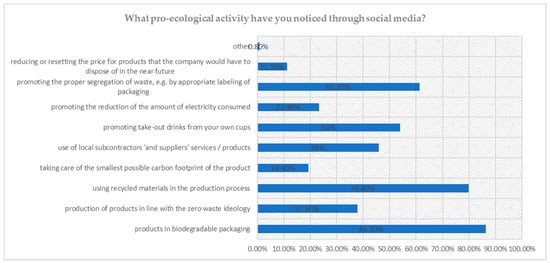
Figure 2.
Awareness of pro-ecological activities of companies in their social media—multiple-choice questions.
4.2. Core Results
The frequency with which respondents encounter posts from ecology-minded companies is shown in Figure 3.
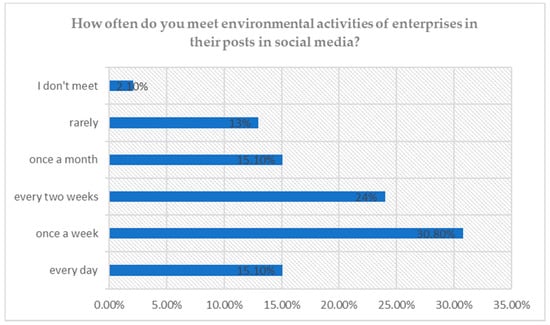
Figure 3.
Frequency of noticing pro-ecological business postings in social media.
In the case of both stationary (85.86%) and online stores (76.43%), a majority of respondents indicated that it was important for them that the products came in biodegradable packaging. It could be thereby inferred that eco-marketing activities of companies in social media would not go unnoticed by them either. Of the group, over a half (67.85%) responded positively that they notice the environmental activities of companies in social media. The respondents’ pro-ecological attitudes towards purchasing decisions are shown in Figure 4.
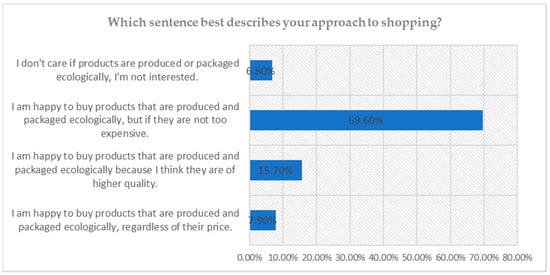
Figure 4.
Shopping strategies of respondents relative to eco-marketing.
Businesses following the ecology-oriented marketing framework must continually turn the spotlight on their activities in order for them to bring the expected conversion rate. Our survey indicates that there is room for improvement. The activities were recognised by 15 people, 66.67% of whom were university graduates from cities with over 100,000 inhabitants. Among the respondents who were not aware of activities in the field of eco-marketing in social media (67 subjects from the population), the distributions of the place of residence, age and education resemble the distribution in the studied population.
The research assumption indicated that middle-aged people (with well-grounded views) and younger paid attention to ecological ideas in the activities of the observed entities more often. From the survey results, it can be seen that: when shopping, 92% of representatives of the age group 18–24 take into consideration (albeit to a varying degree) whether products are organically produced and packaged; a positive response to the question was also provided by 91% of respondents from the 25–34 age group, 95% from the 35–44 age group, 94% of 45–54-year-olds as well as 100% of respondents over 55. Therefore, there is no evidence that would confirm the thesis above, particularly given that only a slightly rising trend in the eco-interest can be observed with the increasing age of respondents in the cohort. To investigate further, we examined the education and the place of residence of the respondents. Of 119 people with higher education, as many as 110 (92.43% of the sample—77 subjects—among whom 70% indicated that they indeed consider the greenness of products while shopping provided that they are not too expensive) were willing to buy biodegradable-packaging products from organic production. Among the respondents with secondary education (70), 66 people (94.28% of the sample—including 54 subjects (81.81%)) indicated that they considered the greenness of products while shopping provided that they were not too expensive, and, concerning primary education, 2 out of 2 people claimed that they were eager to buy products that were produced and packaged ecologically, on condition that they were not too expensive. These data point to a slightly higher tendency to make ecology-driven purchasing decisions with no economic conditioning in the group of respondents from higher education, which may indicate their greater ecological awareness. Certainly, it is not without significance that in this group, 67% of subjects were familiar with the concept of eco-marketing and almost 95% understood the principles of zero waste.
To receive an indication of whether eco-marketing is likely to succeed among different customer groups, it was necessary to verify whether these activities attract the attention of social media users. The distribution of responses regarding the zero-waste marketing in the entire population is shown in Figure 5.
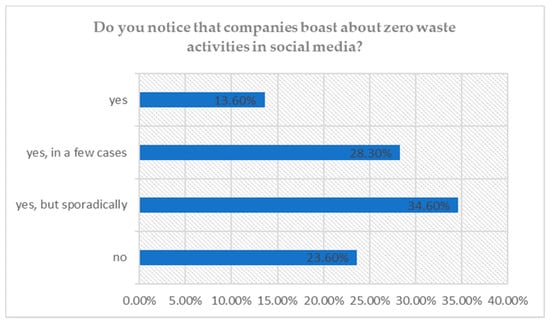
Figure 5.
Awareness of zero-waste activities in social media.
4.3. Answer to the Research Questions.
Fewer than a third of respondents (30.9%) have not yet been introduced to eco-marketing, but most are familiar with the concept. This provides a positive response to the first research question. From the statistical analysis of the responses, it emerges that, regarding research question two, ecological packaging of products is a relevant issue for Polish users of social media discussing the ecological activities of companies. A vast majority of respondents (91.8%) recognise the efforts of manufacturers with respect to eco-packaging and in the field of zero waste. In addition, 86.3% of customers are aware of the social-media-based promotion of bio-degradable packaging (Figure 2). The relevance of these factors for the customer purchase decision-making process is indicated by 69.6% of the respondents (Figure 4). A vast majority of interviewees (91.1%) declare that they know what zero waste is. Customers prefer ecologically manufactured and packaged products provided that their price is not exorbitant. Similarly, a majority of respondents (69.1%) recognise eco-marketing in general, and nearly two-thirds (64.9%) see this marketing technique in social media. Finally, 76.5% (Figure 5) of customers have a high degree of awareness of companies’ zero-waste activities in social media. These results concern the first six of the research questions raised in the study.
The results from the survey were subjected to statistical analysis to answer research questions on the relationship between the familiarity with “zero waste” and the concept of eco-marketing, the noticeability of companies boasting about zero waste or pro-ecological activities in social media and groups divided by age, place of residence, gender and education. To analyse the results in the indicated scope, the following questionnaire questions were selected:
Questionnaire question 1.
“Have you come across the concept of eco-marketing”
Questionnaire question 2.
“What do you think zero waste means?”
Questionnaire question 3.
“Do you notice companies boasting about zero-waste activities in social media?”
Questionnaire question 4.
“Have you noticed pro-ecological activities of companies in social media?”
The relationship between the questionnaire questions and the variables was investigated by means of the χ2 test (significance level α = 0.05). The null hypothesis of the Chi-square test is as follows, H0: X and Y are independent of the hypothesis; H1: X and Y are independent. Table 3 presents the results from the test for independence of the questionnaire questions from the variables: age, place of residence, gender and education.

Table 3.
χ2 test for independence between variables (age, place of residence, gender and education) and responses to questionnaire questions.
Considering the questionnaire questions “Have you come across the concept of eco-marketing” and “What do you think zero waste means?”, there is no evidence to reject the H0 hypothesis of independence between the responses to these questions and the variables: age, place of residence, gender and education; thereby, it cannot be said that the knowledge of “zero waste” and the concept of eco-marketing depends on Polish customers’ socio-demographic profile. With reference to the questionnaire question “Do you notice companies boasting about zero-waste activities in social media?”, the H0 hypothesis of independence between gender and the responses to this question should be rejected in favour of the H1 hypothesis (χ2 = 11.000; p = 0.011), for other variables—there are no grounds to reject the H0 hypothesis. Therefore, it can be concluded that there is an association between gender and the response to this question, and there are no grounds to establish a relationship between the respondents’ responses and age, place of residence and education. A different relationship emerges from the responses to the questionnaire question: “Have you noticed pro-ecological activities of companies in social media?”. The H0 hypothesis of independence between age and the responses to the question (χ2 = 13.282; p = 0.009) and between the gender and the responses (χ2 = 4.732; p = 0.029) must be rejected. Consequently, there is a statistically evidenced relationship between age and gender and the responses to questionnaire question 4, whereas in the remaining variables there are no grounds to reject the H0 hypothesis. Therefore, it can be concluded that the noticeability of companies boasting about pro-ecological activities in social media does not depend on the place of residence and education.
The strength of the relationships was assessed using the gamma coefficient. Given that it is a nonparametric measure of the strength of a relationship between qualitative data, Cohen’s d was implemented to measure the effect of the gamma coefficient. What emerges from the analysis is that the coefficient γ = –0.393 denotes a relationship between the gender and the responses to questionnaire question 4 as significant and medium, while responses to questionnaire question 3 as significant but weak (γ = 0.2529). In the remaining case presented in Table 4, no relationship was determined. There exists a relationship between companies boasting about zero-waste or pro-ecological activities in social media and the customers’ socio-demographic profile (gender).The histogram for the relationship between the gender and the responses to questionnaire question 4 is shown in Figure 6, and for questionnaire question 3 in Figure 7. These data indicate that women are more aware of the ecological and “zero-waste” activities of companies in social media. This result may be explained by the fact that women constitute the majority of users of the zero-waste and ecological groups in social media (Facebook).

Table 4.
The relationship between variables: age, gender, education, and responses to questionnaire questions 3 and 4.
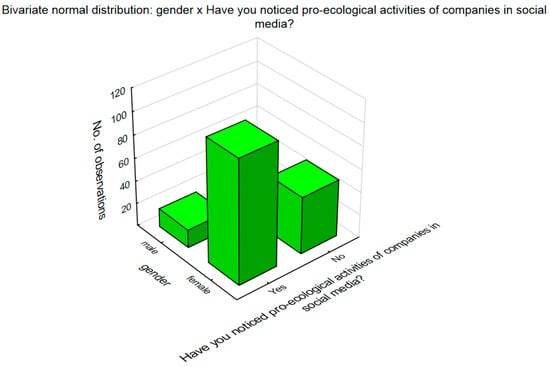
Figure 6.
Histogram of relationships between gender and replies to questionnaire question 4.

Figure 7.
Histogram of relationships between gender and replies to questionnaire question 3.
Subsequently, we set out to reconsider the relationship between age and gender variables so as to establish the changes in the course of this relationship and determine the intervals in which these variables exhibit dependence on the questions in which the relationship was shown. In the case of the questionnaire question “Do you notice companies boasting about zero-waste activities in social media?”, where the dependent variable was age, the group “age 55–64” consisted of only three elements. Due to the small size of the subgroup, these three records were omitted and the test value χ2 = 7.750 was obtained; p = 0.051; therefore, for this range, there are no grounds for rejecting the H0 hypothesis—no dependence of variables can be inferred; hence, these data were analysed further. In questionnaire question 4, as well as in questionnaire question 3, a relationship was shown with the gender variable, which is related to the fact that the data were divided into two categories: women and men.
In the search for the answers to research questions 5–8, the relationship between individual questionnaire questions 1–4 was studied. The Chi-square test revealed no association between questionnaire questions 1 and 2 (χ2 = 12.165; p = 0.432), which indicates a lack of relationship between the questions and translates to the conclusion that customers familiar with the concept of eco-marketing may not be aware of the ideas of zero-waste movements. An analogous conclusion, the lack of relationship, can be drawn with respect to answers to questionnaire questions 1 and 3 (women: χ2 = 9.111; p = 0.693; men: χ2 = 20.140; p = 0.064) and questionnaire questions 4 and 1 in men (χ2 = 2.27; p = 0.684), as well as questionnaire questions 4 and 2 in men (χ2 = 0.820; p = 0.365). In conclusion, customers familiar with eco-marketing may not be aware of companies boasting about zero-waste activities in social media. However, this finding is exclusive to men. To rephrase, male customers familiar with the idea of zero waste may not always be susceptible to companies’ pro-ecological activities in social media. To determine the strength of the relationship between the remaining questions, as conducted in the preceding paragraphs, the gamma coefficient was employed, as shown in Table 5.

Table 5.
Test of independence of answers to selected questionnaire questions.
The data from Table 4 show that a significant and strong relationship occurs between replies to questionnaire questions 2 and 4 in women (γ = −0.739) and between replies to questionnaire questions 2 and 3 in men (γ = 0.6666). A significant and medium relationship was shown between replies to questionnaire questions 2 and 3 in women (γ = 0.3029), and a significant and weak relationship between replies to questionnaire questions 1 and 4 in women (γ = −0.2113). In other cases, the relationship was irrelevant. The results indicate that customers acquainted with zero-waste exhibit a stronger tendency to recognise eco-marketing in social media, and, in women, this tendency also encompasses pro-ecological activities. What is more, noticing companies boasting about zero-waste was found to be weakly correlated with the awareness of pro-ecological activities in social media. This shows that customers cognisant of one of these activities in social media may be oblivious to the other. The histogram for the relationship between answers to questionnaire questions 2 and 4 in women is presented in Figure 8, while for questionnaire questions 2 and 3 in men—Figure 9, and in women—Figure 10.
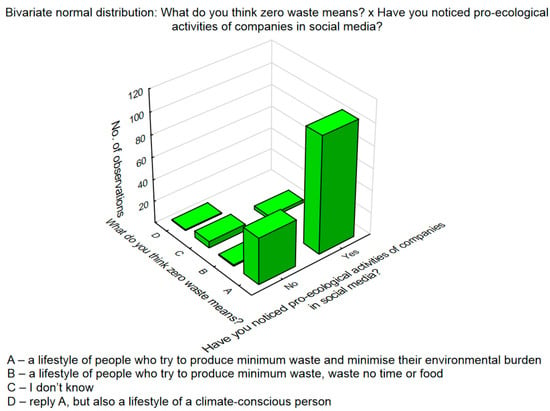
Figure 8.
Histogram of relationships between questionnaire questions 2 and 4.
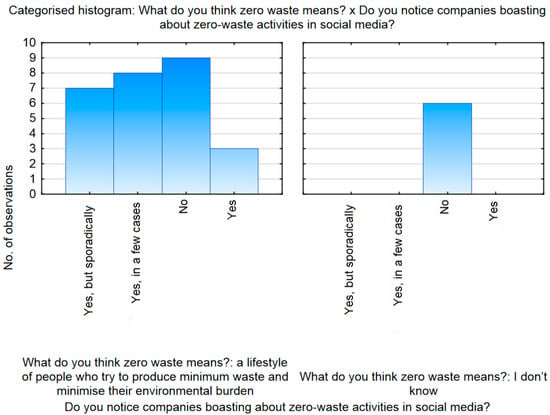
Figure 9.
Histogram of relationships between questionnaire questions 2 and 3 in men.
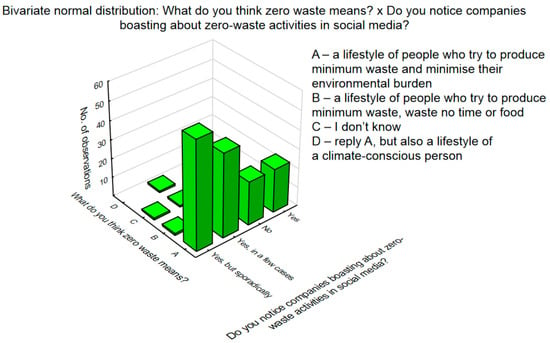
Figure 10.
Histogram of relationships between questionnaire questions 2 and 3 in women.
5. Discussion
The results reported in Section 3 confirm that in the surveyed population, the customer awareness of zero-waste and ecological activities representing green marketing via social media channels is quite high. Moreover, these conclusions correlate with prior observations from our interactions with the members of online green communities. The observed difference was in the degree to which the respondents paid attention to eco-marketing. It was shown that in many cases, the eco-marketing activities are primarily acknowledged through product packaging in ecological materials and promotional activities through posts on social media. These findings are consistent with the current theoretical knowledge of the subject, as packaging is presented as one of the most discernible tokens of green marketing [15]. Similarly, with respect to question four, customers’ preferences have been shown to turn towards products whose manufacturing and packaging is consistent with the principles of ecological awareness as long as the price of the purchase is maintained within a reasonable range. This finding is consistent with the knowledge obtained from other studies concerning the pricing aspect of the customer approach to eco-marketing. This finding indicates that customers in Poland do consider the price of organic products, which is typically higher than the others. While to a certain extent this is regarded as justified, customers would prefer the price of green products to be more reasonable. This may be the starting point for further research on the economic aspect of green marketing.
Our data reveal that eco-marketing activities should be largely targeted at women, who exhibit a stronger tendency to notice these messages. Considering men, it appears that the message directed to this group could be strengthened and refined with respect to choosing appropriate channels and media with a view to attracting their attention. This conclusion correlates with the literature data [31,38], which show that women consistently reported more pro-environmental views and greater levels of concern about specific environmental problems than men. This holds even when controlling for a set of relevant sociodemographic and political variables that earlier research has found to be correlated with environmental concerns. The outcome is contrary to the research by Sun & Wang [18], whose results indicate that men display a more positive approach toward participating in sustainable behaviours (purchasing eco-friendly products) compared to women. The conclusion is confirmed by, e.g., Patel et al. [35], who focused on the Asian market. The result is attributed by the authors to the low level of awareness of environmental issues among women. Traditionally, these are Indian males that are considered responsible for providing economic security to the family and are, therefore, concerned about the economic well-being of the family. Therefore, the limitation of the study concerned the specificity of the study group. Chan, Pong and Tam [47] indicate in their work that certain modifications are required for the widely accepted notion that women are more pro-environmental than men. They demonstrate that gender differences regarding environmental concerns were smaller in societies with higher levels of gender inequality, economic scarcity, power distance and collectivism. Their work was conducted across a variety of cultures: in Argentina, Austria, Belgium, Bulgaria, Canada, Chile, Taiwan, Croatia, the Czech Republic, Denmark, Finland, France, Germany, Israel, Japan, the Republic of Korea, Latvia, Lithuania, Mexico, New Zealand, Norway, the Philippines, Russia, the Slovak Republic, Slovenia, South Africa, Spain, Sweden, Switzerland, Turkey, the United Kingdom and the United States. These results highlight that researchers should not overlook the influence of sociocultural contexts to fully appreciate the role of gender.
What is more, there was a wide range of replies observed with respect to questions regarding the awareness of zero-waste activities and pro-ecological activities in social media in terms of gender. As established, women display a keener eye to such activities. It is worth noting that no strong relationships have been shown considering age, place of residence or education with the answers to the questions concerned with being acquainted with the concept of eco-marketing, or zero waste, as well as the noticeability of companies boasting about zero-waste and pro-ecological activities in social media. It could be indicative of a lower significance of demographics among other relevant factors. This is corroborated by Krishna Reddy and Sudhir Reddy [48], who find that in case of green customer purchase behaviour the psychographic criteria outweigh the demographic criteria. Contrasting evidence and conclusions are presented by Ali and Siong [3,30], who claim that customer knowledge about waste avoidance and minimisation is correlated with age, gender and education. Pro-ecological behaviours, according to Patel et al. [35], depend on, inter alia, age or education. Middle-aged customers were shown to be more environmentally friendly than young or old people. Additionally, the study finds that people with higher education exhibit a higher-degree awareness of this subject than doctors or high-school graduates, which was further confirmed in the study [36]. What is more, older people have been reported to display more pro-environmental customer behaviours than younger people. These findings may support the statement that perhaps the younger generation has not experienced the change that the older generation has undergone. The contrasting results found in the studies described in the literature and the results from our work may be explained by the specificity of the Polish customer market as well as the fact that the study was conducted exclusively on customers in social media. Although the study was limited to the local market, the conclusions are in agreement with the characteristics of other national markets [49]. Another premise that might have limited the study was that the focus was on the group of internet users involved in eco-marketing/social media communities. According to this assumption, customers that may have shown susceptibility to green marketing while not being active users of the web services were precluded from participating and adding to the discussion.
Finally, the conclusion that arises from the presented statistical data is that women who define the term “zero waste” as the lifestyle of people who try to produce minimum waste and minimise their environmental burden are more likely to notice pro-ecological activities of companies in social media. However, if the histogram for “What do you think zero waste means?” and “Do you notice companies boasting about zero-waste activities in social media?” is considered, then among people who define the concept of “zero waste” as a lifestyle of people who try to produce minimum waste and minimise their environmental burden, there is a higher likelihood for women than men to notice such activity in social media. Furthermore, men not familiar with what the term “zero waste” stands for tend not to notice that companies boast about such activities in social media. This is a supplementary aspect analysed in the research.
6. Conclusions
The main drawback of this study is that it has been conducted exclusively on a group of Polish customers. Notwithstanding this limitation, the research practice confirms the validity of our findings on other national markets [49]. Furthermore, since the scope of this work has been limited to the internet and it was the nexus of eco-marketing and social media that was investigated, it does not engage with the results of people who are prone to green marketing and do not use the Internet. However, this was the premise of the study.
The studies concerning the awareness of eco-marketing activities are likely to contribute to the development of new theoretical methods and tools in the field of general marketing. These, in turn, will lead to determining models of effective marketing communication. The acquired theoretical knowledge can be forged by companies into designing eco-marketing campaigns aimed to improve their marketing communication and building lasting relationships with customers. This knowledge may have a crucial impact on future activities in sustainable development undertaken by enterprises for the benefit of the natural environment. To promote their environmental efforts, businesses should ensure that posts on the topic receive regular and quality exposure in social media. The more often they are noticed, the more effective they are in promoting the brand. Although there is a certain degree of user and customer awareness of eco-marketing in social media, there is room for improvement. The ideas of a zero-waste lifestyle deserve dissemination among customers. They are quite observant with respect to such expressions of eco-marketing as eco-organic product packaging or production in the spirit of zero-waste technology. These are two planes that could in the future support customer-company eco-marketing communication, provided that they are managed accordingly. Eco-marketing activities should also be predominantly targeted at women, because they are more likely to take note of the message. However, in men, success might be achieved by reinforcing the message and selecting more appropriate channels of communication and media.
The economic aspect is important to customers. While they respond to eco-marketing messages, they are likely to opt for other products should the green products’ price be higher. This could be an important indicator for companies that decide to raise the prices on the pretext of calling their products organic, i.e., without cost justification.
From the statistical analysis, it can be seen that there is a relationship only between the gender and the responses to two of the analysed questions: medium for questionnaire question 4 “Have you noticed pro-ecological activities of companies in social media?” (γ = −0.393), and weak for questionnaire question 3 “Do you notice companies boasting about zero-waste activities in social media?” (γ = 0.2529). Women were shown to display higher awareness of the zero-waste and pro-ecological activities of companies in social media. In the remaining cases, we did not discover significant relationships.
The independence analysis of responses to selected questions indicates a significant and strong association (γ = −0.739) in women regarding the responses to the questionnaire questions “What do you think zero waste means?” and “Have you noticed pro-ecological activities of companies in social media?”, and in men (γ = 0.6666) regarding “What do you think zero waste means?” and “Do you notice companies boasting about zero-waste activities in social media?”. Among the people who define the concept of "zero waste" as the lifestyle of people who try to produce minimum waste and thus not to pollute the environment, women show higher likelihood than men to notice such activities in social media. Green marketing is taking up a growing share of marketing in general. This could be explained by the fact that it follows from the principles of sustainable development, which is currently one of the most important guiding ideas for effective business activity. The presence of green marketing is felt increasingly strongly not only on the web, but also offline. New directions for eco-marketing can be distinguished, e.g., innovation in the field of product packaging or marketing communication, such as shock advertising or guerrilla marketing, which could exponentially increase its effectiveness. This promising field is open to future extensive studies, as is the economic aspect of purchasing decisions influenced by eco-marketing activities.
Author Contributions
Conceptualization, A.B. and M.K.; methodology, A.B. and M.K.; software, M.K.; validation, A.B. and M.K.; formal analysis, A.B. and M.K.; investigation, A.B. and M.K.; resources, A.B. and M.K.; data curation, A.B. and M.K.; Writing—Original draft preparation, A.B. and M.K.; Writing—Review and editing, A.B. and M.K.; visualization, A.B.; supervision, A.B.; project administration, A.B.; funding acquisition, A.B. and M.K. All authors have read and agreed to the published version of the manuscript.
Funding
This research received no external funding.
Conflicts of Interest
The authors declare no conflict of interest.
References
- Dróżka, W. Coraz Więcej osób Panicznie boi się Zmian Klimatycznych—Alarmują Psychologowie. Available online: https://zdrowie.radiozet.pl/Psychologia/Lek-i-nerwice/Lek-ekologiczny-eco-anxiety-i-depresja-klimatyczna-czym-sa (accessed on 20 May 2020).
- Eco-Anxiety is on the Rise—But That’s not Necessarily a Bad Thing. Available online: https://www.mindbodygreen.com/articles/what-is-eco-anxiety (accessed on 20 May 2020).
- Global Report: Plastic Waste Avoidance “Who Cares?—Who Does?”. Available online: https://insights.gfk.com/global-report-plastic-waste-avoidance-who-cares-who-does?utm_campaign=Global_201910_Plastics&utm_source=Campaign%20LP&utm_medium=CTA%20%7C%20Header%20Banner%20%7C%20Link%20to%20Sample%20Report%20LP (accessed on 10 September 2020).
- Papadas, K.-K.; Avlonitis, G.J.; Carrigan, M.; Piha, L. The interplay of strategic and internal green marketing orientation on competitive advantage. J. Bus. Res. 2019, 104, 632–643. [Google Scholar] [CrossRef]
- Nedumaran, G.; Manida, M. Green Marketing on Customer Behaviour towards Usage of Green Products. Available online: http://dx.doi.org/10.2139/ssrn.3551990 (accessed on 10 March 2020).
- Kemp, S. Digital 2020: Global Digital Overview; Hootsuite & We Are Social: 2020. Available online: https://datareportal.com/reports/digital-2020-global-digital-overview (accessed on 20 May 2020).
- Acharya, A.; Gupta, M. Green marketing: The next marketing revolution. In Green Consumerism: Perspectives, Sustainability, and Behavior; Malyan, R.S., Duhan, P., Eds.; CRC Press: Boca Raton, FL, USA, 2018. [Google Scholar]
- Henion, K.; Kinnear, C.T. A Guide to Ecological Marketing; American Marketing Assocition: Chicago, IL, USA, 1976; p. 1. [Google Scholar]
- Fuller, D.A. Sustainable Marketing; Sage: Thousand Oaks, CA, USA, 1999. [Google Scholar]
- Kumar, V.; Rahman, Z.; Kazmi, A.A.; Goyal, P. Evolution of sustainability as marketing strategy: Beginning of new era. Procedia Soc. Behav. Sci. 2012, 37, 482–489. [Google Scholar] [CrossRef]
- Coddington, W. Environmental Marketing: Positive Strategies for Reaching the Green Consumer; McGraw-Hill Companies: New York, NY, USA, 1993. [Google Scholar]
- Van Dam, Y.K.; Apeldoorn, P.A. Sustainable marketing. J. Micromark. 1996, 16, 45–56. [Google Scholar] [CrossRef]
- Groening, C.; Sarkis, J.; Zhu, Q. Green marketing consumer-level theory review: A compendium of applied theories and further research directions. J. Clean. Prod. 2018, 172, 18448–21866. [Google Scholar] [CrossRef]
- Moravcikova, D.; Krizanova, A.; Kliestikova, J.; Rypakova, M. Green Marketing as the Source of the Competitive Advantage of the Business. Sustainability 2017, 9, 2218. [Google Scholar] [CrossRef]
- Nguyen, A.T.; Parker, L.; Brennan, L.; Lockrey, S. A consumer definition of eco-friendly packaging. J. Clean. Prod. 2020, 252, 119792. [Google Scholar] [CrossRef]
- Grubor, A.; Djokic, I.; Milovanov, O. The influence of social media communication on brand equity: The evidence for environmentally friendly products. Appl. Ecol. Environ. Res. 2017, 15, 963–983. [Google Scholar] [CrossRef]
- Voramontri, D.; Klieb, L. Impact of social media on consumer behaviour. Int. J. Inf. Decis. Sci. 2019, 11, 209–233. [Google Scholar] [CrossRef]
- Sun, Y.; Wang, S. Understanding consumers’ intentions to purchase green products in the social media marketing context. Asia Pac. J. Mark. Logist. 2019, 32, 860–878. [Google Scholar] [CrossRef]
- Papadas, K.-K.; Avlonitis, G.J.; Carrigan, M. Green marketing orientation: Conceptualization, scale development and validation. J. Bus. Res. 2017, 80, 236–246. [Google Scholar] [CrossRef]
- Khan, E.A.; Royhan, P.; Rahman, M.A.; Rahman, M.M.; Mostafa, A. The Impact of Enviropreneurial Orientation on Small Firms’ Business Performance: The Mediation of Green Marketing Mix and Eco-Labeling Strategies. Sustainability 2020, 12, 221. [Google Scholar] [CrossRef]
- Kirgiz, A.C. Green Marketing: A Case Study of the Sub-Industry in Turkey; Palgrave Macmillan: New York, NY, USA, 2016. [Google Scholar]
- Hossain, A.; Khan, M.Y.H. Green Marketing Mix Effect on Consumers Buying Decisions in Bangladesh. Mark. Manag. Innov. 2018, 4, 298–306. [Google Scholar] [CrossRef]
- Obayelu, A.E. Sustainable Consumption and Green Marketing in Developing Countries: Contemporary Perspective Using Nigeria and Kenya as Case Studies. In Green Business: Concepts, Methodologies, Tools, and Applications; IGI Global: Hershey, PA, USA, 2019; pp. 1523–1544. [Google Scholar] [CrossRef]
- Bhalerao, V.R.; Deshmukh, A. Green Marketing: Greening the 4 Ps of Marketing. Int. J. Knowl. Res. Manag. E-Commer. 2015, 5, 5–8. [Google Scholar]
- Stall-Meadows, C.; Davey, A. Green marketing of apparel: Consumers’ price sensitivity to environmental marketing claims. J. Glob. Fash. Mark. 2013, 4, 33–43. [Google Scholar] [CrossRef]
- Huang, H. Media use, environmental beliefs, self-efficacy, and pro-environmental behavior. J. Bus. Res. 2016, 69, 2206–2212. [Google Scholar] [CrossRef]
- Zwier, J.; Blok, V.; Lemmens, P.; Geerts, R.J. The Ideal of a Zero-Waste Humanity: Philosophical Reflections on the Demand for a Bio-Based Economy. J. Agric. Environ. Ethics 2015, 28, 353–374. [Google Scholar] [CrossRef]
- Asveld, L.; van Est, R.; Stemerding, D. Executive summary. In Getting to the Core of the Bio-Economy: A Perspective on the Sustainable Promise of Biomass; Rathenau Instituut: The Hague, The Netherlands, 2011; pp. 11–14. [Google Scholar]
- Nemes, S.A.; Szabo, K.; Vodnar, D.C. Applicability of Agro-Industrial By-Products in Intelligent Food Packaging. Coatings 2020, 10, 550. [Google Scholar] [CrossRef]
- Ali, N.E.H.; Siong, H.C. The Influence of Demographic Variables on Solid Waste Minimization: A Case Study of Shah Alam City, Malaysia. J. Environ. Earth Sci. 2013, 3, 166–173. [Google Scholar]
- Badowska, S.; Delińska, L. The zero waste concept from the young consumer’s perspective. Does gender matter? Ann. Univ. Mar. Curie-Skłodowska Sect. H Oecon. 2019, 53, 7–17. [Google Scholar]
- Soyez, K. How national cultural values affect pro-environmental consumer behaviour. Int. Mark. Rev. 2012, 29, 623–646. [Google Scholar] [CrossRef]
- Steg, L.; Vlek, C. Encouraging pro-environmental behaviour: An integrative review and research agenda. J. Environ. Psychol. 2009, 29, 309–317. [Google Scholar] [CrossRef]
- Trivedi, R.H.; Patel, J.D.; Savalia, J.R. Pro-environmental behaviour, locus of control and willingness to pay for environmental friendly products. Mark. Intell. Plan. 2015, 33, 67–89. [Google Scholar] [CrossRef]
- Patel, J.; Modi, A.; Paul, J. Pro-environmental behavior and socio-demographic factors in an emerging market. Asian J. Bus. Ethics 2017, 6, 189–214. [Google Scholar] [CrossRef]
- Gifford, R.; Nilsson, A. Personal and social factors that influence pro-environmental concern and behaviour: A review. Int. J. Psychol. 2014, 49, 141–157. [Google Scholar] [CrossRef] [PubMed]
- Polo, O.O. Green Conspicuous Consumption: The Effects of Green Marketing Strategies on Consumers’ Behavior. Master’s Thesis, Modul University, Vienna, Austria, 2015. [Google Scholar]
- Xiao, C.; McCright, A.M. Gender differences in environmental concern: Revisiting the institutional trust hypothesis in USA. Environ. Behav. 2015, 47, 17–37. [Google Scholar] [CrossRef]
- Milfont, T.L.; Sibley, C.G. Empathic and social dominance orientations help explain gender differences in environmentalism: A one-year Bayesian mediation analysis. Personal. Individ. Differ. 2016, 90, 85–88. [Google Scholar] [CrossRef]
- Joireman, J.; Liu, R.L. Future-oriented women will pay to reduce global warming: Mediation via political orientation, environmental values, and belief in global warming. J. Environ. Psychol. 2014, 40, 391–400. [Google Scholar] [CrossRef]
- Lόpez-Mosquera, N. Gender differences, theory of planned behavior and willingness to pay. J. Environ. Psychol. 2016, 45, 165–175. [Google Scholar] [CrossRef]
- Dietz, T.; Kalof, L.; Stern, P.C. Gender, values, and environmentalism. Soc. Sci. Q. 2002, 83, 353–364. [Google Scholar] [CrossRef]
- Sagan, A. The Application of Multidimensional Factor Scales and the Rasch Scale in Market Research with Reference to Evaluating the Communicative Effects of Advertising. Zesz. Nauk. Akad. Ekon. Krakowie 2002, 605, 73–92. [Google Scholar]
- Białowąs, S. Skale pięcio- i siedmiostopniowe: W poszukiwaniu optimum. Zesz. Nauk. Akad. Ekon. Poznaniu 2006, 71, 147–151. [Google Scholar]
- Yadav, M.; Rahman, Z. Measuring consumer perception of social media marketing activities in e-commerce industry: Scale development & validation. Telemat. Inf. 2017, 34, 1294–1307. [Google Scholar]
- Ekologiczne Opakowania z Siana. Available online: http://permakultura.com.pl/ekologiczne-opakowania-z-siana/ (accessed on 25 June 2020).
- Chan, H.W.; Pong, V.; Tam, K.P. Cross-National Variation of Gender Differences in Environmental Concern: Testing the Sociocultural Hindrance Hypothesis. Environ. Behav. 2019, 51, 81–108. [Google Scholar] [CrossRef]
- Krishna Reddy, D.N.V.; Sudhir Reddy, M. A study on Impact of Green Marketing on Sustainable Development (With Reference to Khammam District). In National Conference on Marketing and Sustainable Development; Department of Business Administration, Annamacharya Institute of Technology and Sciences (Autonomous): Andhra Pradesh, India, 2017; pp. 86–106. [Google Scholar]
- Song-Turner, H.; Polonsky, M. Enviropreneurial marketing in greening corporate activities: Evidence from four Chinese green firms. Eur. Bus. Rev. 2016, 28, 506–531. [Google Scholar] [CrossRef]
Publisher’s Note: MDPI stays neutral with regard to jurisdictional claims in published maps and institutional affiliations. |
© 2020 by the authors. Licensee MDPI, Basel, Switzerland. This article is an open access article distributed under the terms and conditions of the Creative Commons Attribution (CC BY) license (http://creativecommons.org/licenses/by/4.0/).